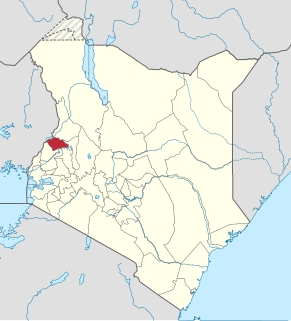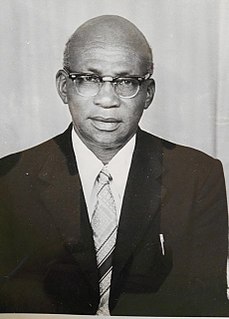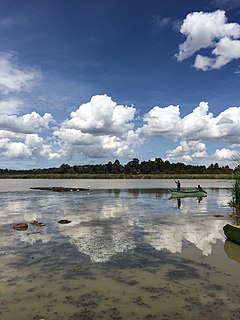Related Research Articles

Eldoret is a principal town in the Rift Valley region of Kenya and serves as the capital of Uasin Gishu County. The town is colloquially known as 'Sisibo'. As per the 2019 Kenya Population and Housing Census, Eldoret is the fifth most populated urban area in the country after Nairobi, Mombasa, Nakuru and Ruiru. Lying south of the Cherangani Hills, the local elevation varies from about 2100 meters at the airport to more than 2700 meters in nearby areas (7000–9000 feet). The population was 289,380 in the 2009 Census, and it is currently the fastest growing town in Kenya with 475,716 people according to 2019 National Census. Eldoret is on course to be named Kenya's fourth city.

Kitale is an agricultural town in northern Rift Valley Kenya situated between Mount Elgon and the Cherangany Hills at an elevation of around 1,900 metres (6,200 ft). Its population is 106,187 as of 2009. Kitale is the headquarter town of Trans-Nzoia County. Kitale is reachable by air through Kitale Airport. The postal code for Kitale is 30200.

Trans-Nzoia County is a county in the former Rift Valley Province, Kenya, located between the Nzoia River and Mount Elgon, 380 km northwest of Nairobi. At its centre is the town of Kitale which is the capital and largest town. The county borders Bungoma to the west, Uasin Gishu and Kakamega to the south, Elgeyo-Marakwet to the east, West Pokot to the north and the republic of Uganda to the Northwest. Trans Nzoia covers an area of 2495.5 square kilometres.

Uasin Gishu County is one of the 47 counties of Kenya, located in the former Rift Valley Province. The city of Eldoret is the county's largest population center as well as its administrative and commercial center.

Nakuru is a city in the Rift Valley region of Kenya. It is the capital of Nakuru County, and was formerly the capital of Rift Valley Province. As of 2019, Nakuru had an urban and rural population of 570,674 inhabitants, making it the largest urban center in the Rift Valley, with Eldoret in Uasin Gishu County following closely behind. The city lies along the Nairobi Nakuru Highway, a distance of 160 kilometers from Nairobi, the capital of Kenya. It is the fourth largest city in Kenya, behind Nairobi, Mombasa and Kisumu respectively. It lies about 1,850 m above sea level.

The Elgeyo are an ethnic group who are part of the larger Kalenjin ethnic group of Nilotic origin. They live near Eldoret, Kenya, in the highlands of the former Keiyo District, now part of the larger Elgeyo Marakwet County. The Elgeyo originally settled at the foothills of the Elgeyo escarpment, in the area between Kerio river to the east and the escarpment to the west. Due to drought and famine in the valley, the Keiyos climbed the escarpment and started to settle on the highland east of Uasin Gishu plateau. When the British came, the Keiyos were pushed to settle in clusters called reserves.

Nandi County is in the North Rift of Kenya, occupying an area of 2,884.4 square kilometres. Its capital, Kapsabet, is the largest town in the county while other towns include Mosoriot, Tinderet, Kobujoi, Kaiboi, Kabiyet and Nandi Hills. According to a 2019 census, the county had a population of 885,711, made up of a number of Kenyan communities, the majority of whom belong to the native tribe called Nandi.

Sub-counties are the decentralised units through which county governments of Kenya will provide functions and services. Except for the parts which fall under urban areas, sub-counties will coincide with the constituencies created under article 89 of the Constitution of Kenya. Sub-counties will be headed by a sub-county administrator, appointed by a County Public Service Board.

Elgeyo-Marakwet County is one of Kenya's 47 counties. Elgeyo Marakwet County is located in the former Rift Valley Province. Its capital and largest town is Iten. It borders the counties of West Pokot to the north, Baringo County to the east, southeast and south, Uasin Gishu to the southwest and west, and Trans Nzoia to the northwest.
Mabati Tatu is a fast growing shopping center close to the border of Bungoma County and Trans-Nzoia County in Kenya. It is located 28 kilometres (17 mi) from Kitale town along the Kiminini – Turbo road. The name 'Mabati Tatu' is a direct translation of Swahili for three iron sheets. This name is in reference to the family of Mzee Patrick Wamalwa Ngome who was the first to settle at the then bushy dirt road intersection.
The Suam–Endebess–Kitale–Eldoret Road, is a rural road in Kenya. The road links Suam, in Trans-Nzoia County, to the towns of Endebess, Kitale, and Eldoret in Uasin Gishu County.
The Kisumu–Kakamega–Webuye–Kitale Road, is a rural road in Kenya. The road links Kisumu, in Kisumu County, to the towns of Kakamega, in Kakamega County, Webuye in Bungoma County, and Kitale in Trans-Nzoia County.

Paul Kiplimo Boit was a prominent KANU politician during the Moi Regime. He was the Chairman of Sirikwa County Council (which later came to be divided to Nandi County, Uasin Gishu County, Trans Nzoia County, West Pokot County Elgeyo Marakwet County from 1964 to 1971 and later became the Chairman of Wareng County Council one of five Councils split from Sirikwa covering Uasin Gishu. He was best known for his excellent farming skills which earned him many awards and a visit from the former Tanzanian president Ali Hassan Mwinyi

The Nairobi–Malaba Road, also Nairobi–Uganda Road or A104 Road (Kenya) is a major highway in Kenya, the largest economy in the East African Community. The road connects Nairobi, the capital and largest city in Kenya, with the border town of Malaba at the international border with Uganda.
Sirikwa holes are saucer-shaped hollows found on hillsides in the western highlands of Kenya and in the elevated stretch of the central Rift Valley around Nakuru. These hollows, each having a diameter of 10–20 metres and an average depth of 2.4 metres, occur in groups, sometimes numbering fewer than ten and at times more than a hundred. Archaeologists believe that construction of these features may have begun in the Iron Age.
Kwanza is a town in Trans-Nzoia County in western Kenya, close to the international border with Uganda. It is the headquarters of Kwanza Ward, one of the constituent wards in Kwanza Constituency.

The Sengwer people are an indigenous community who primarily live in the Embobut forest in the western highlands of Kenya and in scattered pockets across Trans Nzoia, West Pokot and Elgeyo-Marakwet counties. The Sengwer are sometimes portrayed as a component of the Marakwet people but are a distinct ethnic grouping.
The Settlement of Nandi was the historical process by which the various communities that today make up the Nandi people of Kenya settled in Nandi County. It is captured in the folklore of the Nandi as a distinct process composed of a series of inward migrations by members from various Kalenjin ortinwek.

The Sirikwa culture was the predominant Kenyan hinterland culture of the Pastoral Iron Age, c.2000 BP. Seen to have developed out of the Elmenteitan culture of the East African Pastoral Neolithic c.3300-1200 BP, it was followed in much of its area by the Kalenjin, Maa, western and central Kenyan communities of the 18th and 19th centuries.

Kesses Dam is a small man-made lake in Kenya. It is one of the sources of the Yala River. It is used as a source of water for irrigation and domestic use, and also for boating and other water activities.
References
- ↑ Electoral Commission of Kenya: Registration centres by electoral area and constituency Archived 2008-06-25 at the Wayback Machine
- ↑ UN Office for the Coordination of Humanitarian Affairs (OCHA): Kenya_AdminLevels_1-4
- ↑ Cecil Hoey and Hoeys Bridge (now Moi's Bridge), Old Africa Magazine, Jan 2015 online
- ↑ Cecil Hoey and Hoeys Bridge (now Moi's Bridge), Old Africa Magazine, Jan 2015 online
- ↑ Zakenya online
- ↑ The Rough Guide Map - Kenya